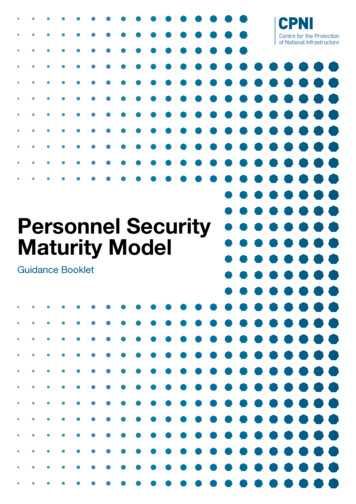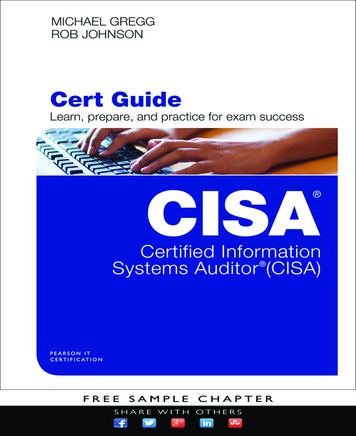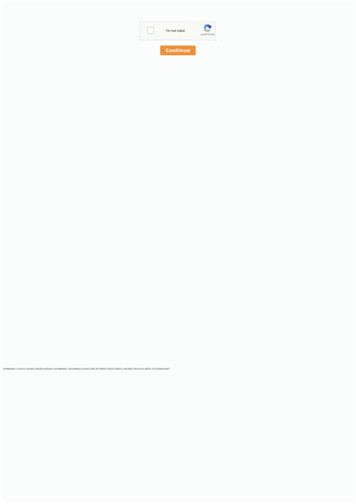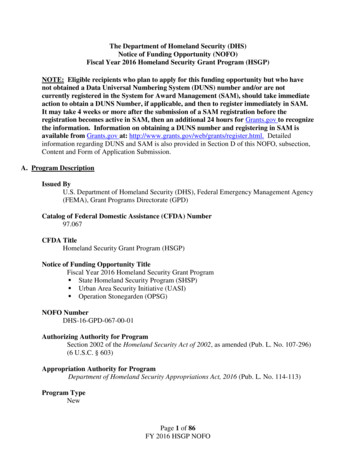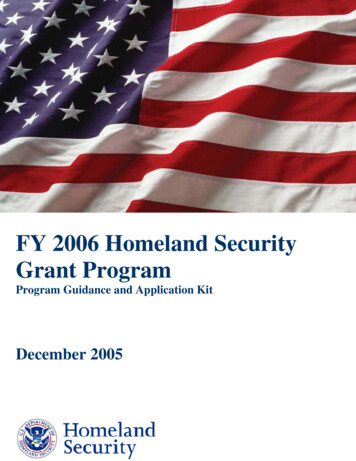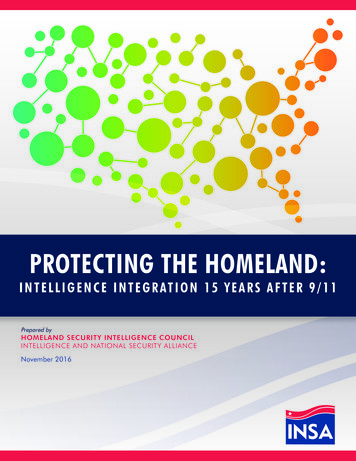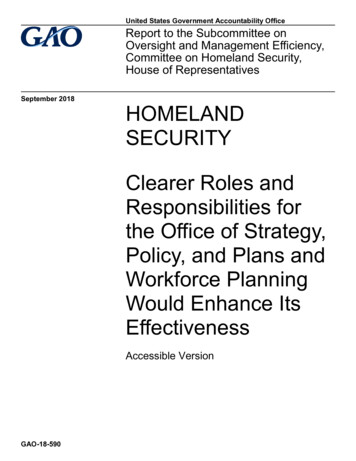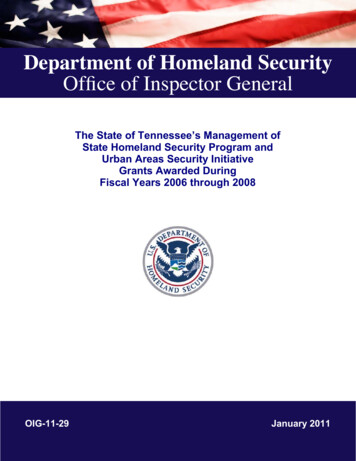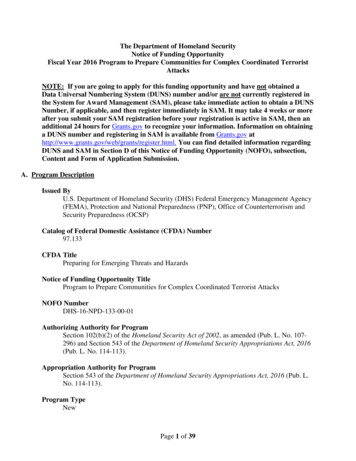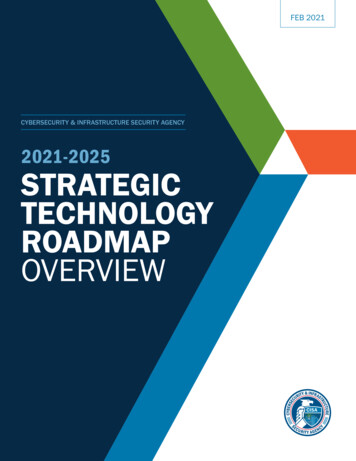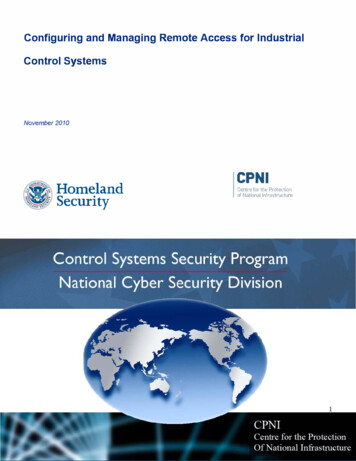
Transcription
Configuring and Managing Remote Access for IndustrialControl SystemsNovember 2010HomelandSecurityCPNICentre for the Protectionof National Infrastructure
DisclaimerThis report was prepared as an account of work sponsored by an agency of the U.S.Government. Neither the U.S. Government nor any agency thereof, nor any employee, makesany warranty, expressed or implied, or assumes any legal liability or responsibility for any thirdparty’s use, or the results of such use, or any information, apparatus, product, or processdisclosed in this publication, or represents that its use by such third party would not infringeprivately owned rights.1
Executive summaryIndustrial control systems play a vital role in critical infrastructure. The requirementsfor their high availability and proper functioning demand that the systems beprotected from both intentional and unintentional incidents that can impact theiroperation. In the past, the risk to these systems was mitigated by ensuring completeseparation of operational domains from external networks and access to the controlfunction was limited to authorised users with physical access to a facility. Today,business demands (such as increased and faster online access to real-time data,using less resources) has led to the rapid deployment of modern networkingtechnologies, which has accelerated the interconnectivity of these once isolatedsystems. This new connectivity has empowered asset owners to maximise businessoperations and reduce costs associated with equipment monitoring, upgrading andservicing, whilst creating a new security paradigm for protecting control systems fromcyber incident.Part of the security equation involves how operational assets are accessed andmanaged and how the cyber security posture of a control system can be impacted ifthe management of remote access is not understood by business or is conductedpoorly. However, as is the case with modern cyber security countermeasures, theapplication of proven and accepted remote access solutions may not map perfectlyto control systems environments. Requirements for availability and integrity,combined with the unique nuances and attributes often found in ‘purpose built’systems, drive new demand for guidance as it pertains to creating secure remoteaccess solutions for industrial control systems environments.This good practice document provides support for developing remote accesssolutions for industrial control systems. Common good practices from standardinformation technology solutions will be presented in the context of control systemsenvironments, along with insight into how remote access solutions can be deployedin a manner to mitigate cyber risk unique to control systems architectures. The goalof this practice document is to provide guidance regarding the development ofsecure remote access strategies for industrial control systems environments.In using this practice guide, no two control systems will be identical. As such, nosingle secure remote access solution is applicable to all possible architectures andno single remote access solution can provide adequate security without a defencein-depth approach. However, by exercising caution and generating and implementingconcise requirements based on good analysis, secure remote access solutions canbe deployed and maintained.KeywordsIndustrial control systems, SCADA, remote access, role-based access control,remote connectivity, monitoring, secure vendor access, defence-in-depth, firewall,intrusion detection, encryption, demilitarised zones, security zones, policy andprocedures, patch management.2
ContentsExecutive summary . 2Keywords. 2Recommended practice: configuring and managing remote access for controlsystemsIntroduction and definition. 5Remote access in industrial control system architectures. 8Roles and remote access in control system architectures . 9System operators and engineers for local systems . 10System operators and engineers for remote systems . 10Vendors . 10Integrators and system support specialists. 11Field technicians . 12Business partners . 12Customers . 13Supply chain operations. 13Managed service providers. 13Other considerations. 14Unintentional entry points . 15Remote access in modern ICT architectures . 17Requirements . 17Types of remote access solutions . 18Security Considerations . 22Determining requirements. 23Attack vectors . 23Secure communications. 25Access control. 25Logging and reporting . 26Network architecture security. 28Improving security. 29Remote access in control systems architectures . 32Remote access security considerations unique to control systems . 33Applying good practices . 35Periodically undertake formal threat and risk assessments. 36Eliminate all direct connections. 37Secure modem access . 38Create a physical and logical DMZ separating corporate and IT environments . 38Create separate authentication servers for separate roles (vendors/integrators). 39Enforce a security assurance policy for all remote access . 40Full tunnels. 40Password policy . 42Two form factor authentications. 43Authorisation levels. 443
Dedicated client hardware and software. 45Session termination . 45Managing remote access in control systems environments . 47Case study: Marstad municipal operations. 48Background. 49Control system architecture . 49Risk factors . 51Solutions for securing the municipality’s remote access. 53Conclusion . 56GlossaryAcronyms . 58Nomenclature . 59Figures and tables . 61Further reading . 62References. 654
Recommended practice: configuring and managingremote access for control systemsIntroduction and definitionInformation infrastructures across many public and private domains share several commonattributes regarding information and communication technology (ICT). This is particularly true inthe industrial control systems domain, where an increasing number of organisations are usingmodern networking to enhance productivity and reduce costs by increasing the integration ofexternal, business and control system networks. However, these integration strategies oftenlead to vulnerabilities that can greatly reduce the cyber security posture of an organisation andcan expose mission-critical industrial control systems to cyber threats. The opportunities forenhancing business operations are seemingly endless, with one of the major advantages beingthe ability to increase the command and control function by leveraging remote accesscapabilities. Without applying appropriate security safeguards, remote access functionality cancreate opportunities for cyber adversaries wishing to cause harm or damage to criticalprocesses that may seriously affect the lives of people, health, society, the economy and theenvironment.This document provides guidance for developing secure remote access strategies fororganisations that use industrial control systems. This document is to be used in developing orupdating strategies related to managing remote connectivity between operational assets, peers,vendors, operators and other elements that require access to critical information, devices orprocess data.From a definition perspective, this document will assume that remote access is defined, in itssimplest form, as ‘the ability for an organisation’s users to access its non-public computingresources from external locations other than the organisation’s facilities.’ 1 To extend this tocontrol systems, consider that remote access also includes ‘accessing data, a system, or aservice inside a physically and/or logically protected network from a system or device outsidethat network.’ Combining the two, the definition of remote access for this practice guide is:‘The capability for an organisation’s users and operators to access its non-public computingresources, data and systems that reside inside a physically and/or logically protected networkfrom external locations that may be considered outside that organisation’s network.’This definition is useful in many circumstances, a in particular in control system domains and hasseveral security elements that are applicable to this practice guide: It provides allowances for the fact that a single operator may have administrative oversightover several disparate systems that are considered to be within an organisation’sinformation enclave. It implicitly acknowledges that remote access can be interrupted, prevented, captured orhijacked through deliberate actions of a separate party without that party having tocircumvent physical or logical security controls, even when the communications aretravelling across media owned and operated by the data/system owner.a. A more rigorous definition is ‘data communications from one network enclave to another network enclave; where a networkenclave refers to a networked group of one or more systems partially isolated from other systems using some protectionmechanism, either logical, physical, or both.’5
It can exclude communications within physically protected areas, such as compounds orbuildings, reducing the scope of the discussion (security of communications within physicallyprotected boundaries is still an important issue, but should be considered separate from andbeyond the scope of remote access). It includes all communications over equipment whose physical and logical security cannotbe validated explicitly by the organisation using the equipment in an area of communicationssecurity that traditionally does not receive enough attention, even today.This definition expands the scope of remote access to include examples that traditionally havenot been considered ‘remote access.’ For example, connections between geographicallydisparate sites using private third-party telecommunications lines are not normally consideredremote access, despite the fact that the telecommunications lines are owned by a separatetelecommunications company and leased by the organisation looking for a communicationmechanism between two sites. However, they are included in this definition. The definitionencompasses long-range communication channels, such as fibre or microwave, where theequipment is owned by the data or service owner, but the physical security of the transmissionmedia is outside the direct control of the data owner.Remote access security functionality and features help create electronic pathways to grantauthorised and authenticated access into a trusted network from a location that would otherwisebe considered untrusted. In this definition, the non-public (trusted) network would be consideredthe control system network.Although this document is titled Configuring and Managing Remote Access for Control Systems,the material is intended to be applicable to any architecture involving industrial control systems,process control systems, Supervisory Control and Data Acquisition (SCADA), or distributedcontrol systems. The term industrial control systems is to be considered a general term applyingto all these system types sharing similar characteristics and is in line with the definitions used bythe contemporary communities of interest and other standards bodies.BackgroundThe critical infrastructure systems that support major industries, such as manufacturing, water,transportation and energy, are highly dependent on information systems for their command andcontrol. While a high dependence on legacy industrial control systems still exists, criticalindustrial control systems are migrating to new communication technologies. As a result,common communications protocols and open architecture standards are replacing the diverseand disparate proprietary mechanics of industrial control systems. This replacement can haveboth positive and negative impacts, especially in the areas of system integration and support.While the traditional isolation of the control system demanded onsite maintenance fromintegrators and vendors, modern communication mechanisms can facilitate remote connectivityfrom almost anywhere. In addition, this new interoperability provides for operators and assetowners to allow their own disparate resources to remotely connect to their control systems fromanywhere on an as-needed basis. As is the case with any contemporary ICT architecture, thecyber risk is proportional to the security countermeasures deployed to protect againstunauthorised remote access.The protocols and communication standards that provide increased interoperability in theindustrial control systems community build on and use, in many cases, the same technologiesthat have been exploited and compromised on the internet and corporate networking domains.The same is true for those technologies associated with remote access and this can often6
create situations that cause industrial control systems to inherit undesirable securityvulnerabilities. Research indicates that the mitigation strategies used in contemporary ICTsystems may not always align perfectly to the industrial control systems domain. The uniquenuances associated with both availability and integrity within control system architecturesrequire that contemporary security countermeasures be deployed with a specific purpose.Figure 1 provides a notional diagram that illustrates the traditional isolation of a control systemenvironment from supporting corporate architectures and peer sites. This simplified viewshowcases that access to the control system domain, be it for system operation or systemsupport, was either by physical access to the facility or remote access via telephonic means(modem). This illustration is a very good approximation of traditional legacy architectures andshowcases traditional vendor access provided by a dial-in capability. Onsite support, which wasoften the norm, would tend to be expensive due to time and materials and organisations lookedfor ways to reduce costs wherever possible. With regard to security, access policies andcontrols were developed based on the assumption that external environments contained threatsthat were both malicious and hostile.(Figure 1: Traditional isolation of corporate and control domains)But as interoperability also provided solutions for cost reduction and ease-of-use, access intothe control systems environment was extended beyond simple modem and physical access. Asorganisations grew, the requirements related to reporting and business oversight also expandedand continued to expand. This drives the need to facilitate operational information to differentareas of the business and that could include regulatory authorities, remote operations, peer7
sites, partners and even application and hardware vendors as well as third parties providingservices.Remote access in industrial control system architecturesFigure 2 shows an integrated architecture that has connections from external sources such asthe corporate local area network (LAN), peer sites, vendor sites and the internet. This graphicalso illustrates the concept of an external communications infrastructure, an element common incontrol systems architectures, be they localised or disparate across large geographic areas. It isthis external communications infrastructure that supports connectivity to elements of remoteoperations, remote facilities, business partners and vendors. The external communicationsinfrastructure could also be considered a connection point to the internet, the current de factomechanism for remote users to gain access to business or control system operations (i.e.telecommuting).(Figure 2: Integrated networks)From figure 2, the integrated architectures, if compromised, clearly could provide an attackerwith various avenues for accessing critical systems, especially if remote access mechanismsare taken into consideration. The issue of convergence raises concerns regarding how attackerscould create vectors into trusted control architectures simply by compromising trusted resourcesin remote operations, remote facilities, remote business partners and even vendors. These8
issues clearly showcase the importance of creating effective and secure remote accesssolutions when dealing with mission critical control systems. But as discussed above, theimplementation of secure remote access strategies can in many cases be nontrivial as therequirements regarding availability and integrity make standard solution deploymentsimpractical and ineffective. More importantly, the deployment of a secure remote accesssolution may not only increase the cyber risk profile of a control system environment but maynegatively impact the necessary attributes of high availability and data integrity.Roles and remote access in control system architecturesBecause securing remote access is an integral part of any defence-in-depth strategy, thefoundation of creating usable guidance as it pertains to control systems environments mustinclude both users and the technology to be accessed remotely. To generalise control systemarchitectures is difficult and to develop a recommended practice for securing remote access thatis applicable to all architectures is impossible. The uniqueness and diversity of both vendor andpurpose-built systems create a landscape of diversity that simply cannot be addressed with asingle solution. However, common elements, such as users, roles, existing technology andarchitecture types, can be reviewed and their attributes can be leveraged. It may helporganisations to shape their remote access strategy by determining who requires access tocertain resources as well as understanding attack vectors that can be created unintentionally.Understanding both users and roles can have a significant impact on how the remote accessstrategy evolves. In most control systems operations, the roles that would require remoteaccess to control assets may include, but are not limited to: System operators and engineers for local systems System operators and engineers for remote systems Vendors System integrators System support specialists and maintenance engineers Field technicians Business partners Reporting or regulatory entities Customers Supply chain representatives Managed service providersDeveloping a list that is complete for all systems in all sectors is not possible and the list shouldbe augmented as needed. The roles of the users that would require remote access to missioncritical operations can be extensive and the assignment of specific access depending on thoseroles can be complicated at best. The assignment of remote access roles and credentials isexpected to be embedded in the organisational cyber security policy supported by the remoteaccess methodologies discussed in this paper. Here, some of the more common roles arereviewed in developing a control system remote access strategy.9
System operators and engineers for local systemsThe people who have the most need for access into a control system environment are going tobe the regular system operators and the system maintenance engineers. The requirements forremote access to local systems are best understood when the growth or expansion of a controlsystem will require an operator or engineer to have oversight over disparate (but connected)resources. Modern networking does not always facilitate connectivity that automatically createsaccess control permission structures and if it does, it certainly will incur a cost. Asset ownersrely on the concept of flat networking to allow operators and engineers to have both local andremote access to mission-critical systems. b Local systems, by definition, include informationresources that are not actually situated on the control system network. But, they are located onconjoined domains that are, for example, responsible for aggregating operational data orpreparing content for a customer web-based service.Access to and from critical control system assets in the modern environment is usually LANbased, but still should be considered remote if the operator is traversing across differentnetworks. Virtual Private Networking (VPN) is often considered the best approach in securingtrans-network communication. Surprisingly, many organisations feel that thesecountermeasures are often unnecessary due to the trust relationship that exists betweenoperator consoles and services requiring access. Trust relationships inherent in most controlsystem domains not only involve operators but also field device technologies. The foundation ofcontrol system operations incorporated exclusive trust between operators and field devices,which was a capability well suited for completely isolated networks. Unfortunately, this trust hasbeen carried over into modern control system architectures and this inherent trust is easilyexploited by an adversary that has managed to compromise the control system or administrativenetworks.System operators and engineers for remote systemsAs control systems environments continue to grow both in terms of size and capability, assetowners will be faced with the challenges of maximising operations while managing expensesrelated to personnel. These requirements will introduce demands for an organisation to have anoperator administer more than one system in order to optimise operations. More importantly,asset owners need to consider the emerging complexity of distributed environments thatfacilitate single operators having responsibility over many disparate elements. In many cases,the operator will not need the same levels of authoritative access across all environments.Obviously, this can impact the access profiles an engineer can have when managing operationsacross several system domains.VendorsTraditionally, asset owners were not concerned about remote access activities from vendors.When systems were completely and totally isolated from any external connectivity and the onlyaccess to the network was either physical or by modem, entities felt comfortable with the riskassociated with vendor remote access. In modern control systems environments, vendors oftendeploy their technology complete with remote access (e.g., a modem) embedded into theb. To enhance productivity, it is not uncommon for asset owners to assign processes and procedures specific access capabilitiesacross flat networks.10
solution to expedite timely support operations, operations that can include system restoration,system upgrades and performance monitoring. Vendors can perform these functions as part ofa larger support services contract. In many cases, these contracts demand that remote vendoraccess be available and not necessarily include operator interaction.The impact of vendor access on control system security posture is interesting. The electronicsecurity perimeter associated with protecting ingress and egress data streams becomes veryethereal and hard to qualify. Whereas the traditionally isolated model allowed the asset owner toclearly define the security perimeter, the protection of the information enclave is now theresponsibility of the vendor with the remote access. Technically, all the points of presence thevendor has on the internet could conceivably expose the asset owner, thereby changing the riskprofile of the control system dramatically as soon as remote access is obtained. This issue isthe cornerstone of the argument that control system solution vendors must provide adequatesecurity countermeasures for remote access into the systems they are supporting and that thehistorical trust relationship shared between a vendor and an operator can no longer be assumedto be safe and uncompromised.Asset owners that rely on remote access from vendors to support their operations shouldconsider a number of different factors in developing their overall remote access strategy. Thesecan include, but are not limited to: The procurement guidance language (see Reference 1) may be used to agree on theestablishment of a guaranteed secure remote connection between the vendor and theowner’s control system. Asset owners should be aware that the vendors could be exposed to untrusted andhostile environments. A compromised vendor network could enable an attacker topiggyback on a trusted connection into the control system. Vendors will usually require remote access for two reasons: emergency operationalsupport and system maintenance. Asset owners should recognise that the latter ofthese two can be scheduled and definitive protocols for remote access connections canbe established and monitored. Asset owners need to be aware of the possibility that a vendor can deploy their remoteconnectivity solutions (i.e., modems) in a standardised manner and as such theauthorisation credentials used to access a large number of control systems may be verysimilar if not identical.Integrators and system support specialistsGenerally speaking, integrators differ from vendors in several ways. With regard to remoteaccess, the most critical difference is the presence of an integrator in solution provisioning thatoften prevents the asset owner from directly interacting with the vendor. Although it is notuncommon for an integrator to also be a vendor, this single degree of separation can greatlyinfluence the cyber risk posture of an organisation. Indeed, the remote access issues relevant tovendors may also be applicab
resources, data and systems that reside inside a physically and/or logically protected network from external locations that may be considered outside that organisation's network.' This definition is useful in many circumstances, a in particular in control system domains and has several security elements that are applicable to this practice .
